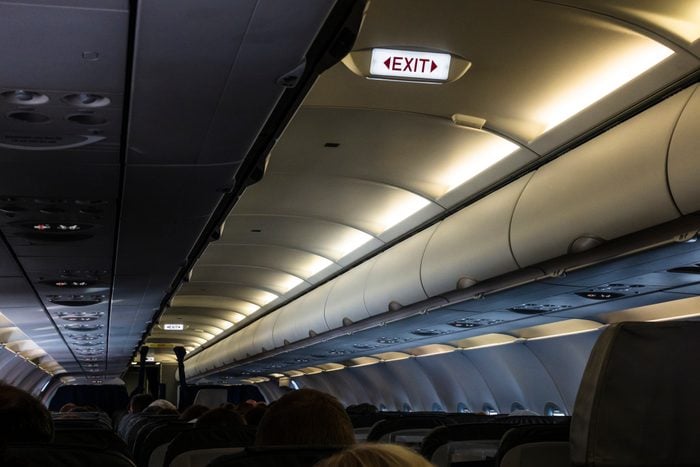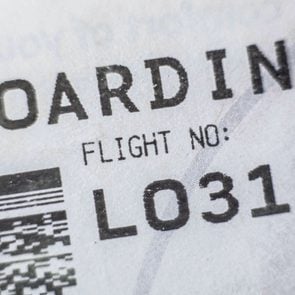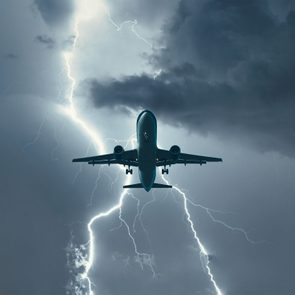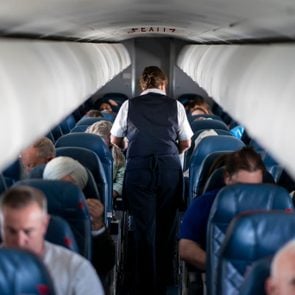The Surprising Reason Airline Crews Dim the Cabin Lights (It’s Not to Help You Sleep)
Updated: Mar. 25, 2024

Why are airplane lights dimmed during takeoff and landing? An aviation expert explains.
As frequent fliers and anyone familiar with airplane travel are well aware, when the cabin crew dims the lights, it’s a sure signal that your plane is either ready to depart or land. It may be a moment of excitement or relief, depending on how long you’ve been traveling and how excited you are about your destination. But wherever you fly—on a long-haul flight or a quick commuter hop—the lights being dimmed on a plane isn’t just to help you catch some shut-eye. Like putting phones in airplane mode or keeping your seatbelts fastened, it’s actually a protocol of air travel.
But why does the crew need to dim the lights? This is one of those bits of airplane trivia that might surprise you. We spoke with a former pilot and aviation expert about the real reasons cabin lights are dimmed.
Get Reader’s Digest’s Read Up newsletter for travel, humor, cleaning, tech and fun facts all week long.
Why do cabin crews dim the lights during takeoff and landing?
Like many hidden airplane features, dimming cabin lights at takeoff and landing is solely a safety precaution. It applies to worst-case scenarios that, admittedly, most of us don’t want to think about while we’re flying. “During dawn, dusk and night, flight crews dim the lights so that in case of an emergency where passengers and the flight crew have to abandon the aircraft, their eyes already are adjusted to the dark,” says Dan Bubb, PhD, a former airline pilot, current associate professor at the University of Nevada, Las Vegas, and expert on commercial aviation and airport history.
It can take 5 to 10 minutes for someone’s eyes to adjust to the dark if they have been in bright light conditions, adds Bubb. So if passengers and crew have to act fast in an emergency, their eyes will be acclimated to the dimmer lights and lower visibility in the cabin. When the overhead lights are turned off, it’s also easier for passengers to see emergency exit lights, including those running along the aisle floor.
Why are takeoff and landing particularly dangerous times on a flight?
Dimming of the lights is done for passenger and crew safety, but why only at takeoff and landing? Aircraft manufacturer Boeing compiles an annual log of commercial airline incidents and fatalities, and tracks the phase of flight where these accidents occur. By wide margins, takeoff and landing are the two most dangerous times in an airplane’s journey. In fact, 21% of fatal accidents occur at takeoff and initial climb, and 46% of all fatal accidents occur during final descent and landing.
“Takeoff and landing are the most critical phases of flight because so much is happening for pilots,” says Bubb about the disconcerting figures. “This includes monitoring aircraft systems, scanning the airport environment for other aircraft and impediments while listening to air traffic control instructions, and being prepared in case we have to abort the takeoff or reject the landing.”
Additionally, he says, these two flight phases are when the aircraft is in “dirty configuration,” which is industry-speak for when wing flaps and landing gear are down. The airplane is also flying at a lower speed at these times. “If the pilots are not paying attention, and the aircraft flies too slowly, it will lose lift and do what we call a stall.” And stalls have resulted in deadly crashes.
(For what it’s worth, fatal incidents are incredibly rare in air travel: According to the International Air Transport Association, the fatality risk is so low, a person would need to take a flight every day for 25,214 years to experience a 100% fatal accident.)
For what other reasons do airplanes dim the lights?
On flights that occur after dark or that travel from daylight to nighttime hours, you can also expect the crew to dim the lights. They’ll turn them on and keep them on after takeoff, long enough for passengers to settle in, get comfortable (when it’s inevitably cold on airplanes), eat a meal, order their drinks and find a movie to watch during the flight. After that, the lights will go out again. Dimming them conserves energy as well, and it’s also conducive to rest for passengers who want to try to sleep on the plane.
Bubb says that protocol for other lighting decisions involves safety and efficiency. On the exterior of the plane, he says, “we turn on the lights during takeoff and landing to be seen by other aircraft.” After that, most external lights are turned off so they won’t burn out. And after a plane has landed, he says, “we turn off the landing lights so we don’t blind other pilots, because the lights are very bright.”
About the expert
- Dan Bubb, PhD, is a former airline pilot and the current associate professor in residence at the University of Nevada, Las Vegas. He is the author of Landing in Las Vegas: Commercial Aviation and the Making of a Tourist City, and his research interests include U.S. and world history and commercial aviation and airport history.
Sources:
- Boeing: “Statistical Summary of Commercial Jet Airplane Accidents”
- International Air Transport Association: “IATA Releases 2022 Airline Safety Performance”



